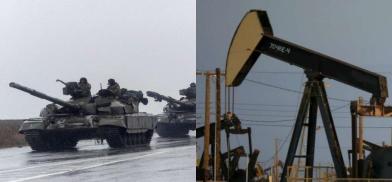Ukraine war unlikely to impact Indian economy in a big way
Given the meager oil dependency on Russia and India’s past experience to tackle global oil price shocks, the Russia-Ukraine conflict is unlikely to cause any major impact on the economy, writes S. Majumder for South Asia Monitor

The Indian economy was expected to bounce back after the great shock of Covid-19 pandemic. But hopes were belied as Russia militarily invaded Ukraine on February 24. The war shows no signs of abating in the near future.
Oil prices have shot up, stoking inflation and denting the Indian budget expectations. The stock market has plummeted. Fall in bond prices raises borrowing costs. The supply chain industry – accounting for three-fourths of world trade -- is in shambles. Noted economist Swaminathan S. Anklesaria Aiyar has warned that Ukraine will derail Finance Minister Nirmala Sitararaman’s 'dream budget'.
In the near term, this may be true. In the long term, however, the fear is baseless. The crucial issues are oil shock and the significance of the India-Russia trade.
India’s sanction experience
It is not the first time that India has faced global sanction on oil and trade. Sanctions against Iraq and Iran are cases in point. India managed to challenge the sanctions by adopting 'food for oil' and 'oil bond strategies. Given these, sanctions against Russia are unlikely to ruffle many feathers.
This is because, first, Russia accounts for only 2 percent of India’s overall imports of crude oil. Second, though the direct impact is less, the global impact of oil price hikes looms large. To this end, it is argued that India has the experience to tackle a global oil shock. As regards trade, trade between Russia and India - except in military hardware - is insignificant.
During the period between 2012-13 and 2014-15, global oil prices escalated the basket price for imported crude oil, ranging from $106-111 per barrel, and pushed up inflation (in terms of CPI). In contrast, GDP increased by 5.4 percent in 2012-13, inched up to 6 percent in 2013-14, and spurred to 7.1 percent in 2014-15. Although oil prices and inflation spurred eventually, India’s growth remained resilient.
In India, oil is not the main energy for manufacturing. Rather, it is the energy for transport and cooking. Nearly, 65 percent of oil products such as petrol, diesel and LPG are used for transportation and cooking energy. Of these, 51 percent of oil is consumed for transportation and 14 percent is consumed for cooling energy. Coal is the main energy for manufacturing and power for agriculture. In the total energy basket (coal, oil, hydro, nuclear and lignite), oil accounts for one-fourth and coal for 65 percent.
Oil imports
No doubt, India is import-dependent in oil. Nearly 90 percent of crude oil demand is met by imports. Given the meager oil dependency on Russia and India’s past experience to tackle global oil price shocks, the Russia-Ukraine conflict is unlikely to cause any major impact on the economy.
As regards India-Russia trade, it turned insignificant after the breakdown of the Soviet Union. Currently (2020-21), Russia accounts for less than 1 percent of India total exports, against 2.5 percent in 1997-98 and 1.4 percent of total imports against 1.3 percent in 1997-98. In pursuance of India’s great economic reform in 1991, which opened a bigger scope for manufacturing dynamism, India’s global trade made a dynamic shift to the US, EU and South-East Asia. The Look East policy and India’s nuclear deal with the US paved the way for this shift in global trade.
Till 2000, Russia was an important export destination. India had a favourable trade balance, exporting more to Russia and importing less from it. It was an important destination for export of consumer goods like tea, readymade garments and pharmaceutical products. Consequent to structural changes in manufacturing, India vied for global integration, shifting towards new technology base manufacturing and focusing on export of electronic and automobile industries.
India-Russia trade
Since much of the trade between India and Russia is in rupee-rouble terms, sanctions against Russian banks using SWIFT (Society for Worldwide Interbank Financial Telecommunication) will reduce trade between the two countries. Nevertheless, excepting tea, Russia does not hold a major market for Indian goods. Russia accounts for 2.6 percent of India’s total export of tea and coffee.
Russia is not a major foreign investor in India. During April 2000 to June 2021, Russian investment in India was just $1.26 billion, which is less than 1 percent of the total FDI in the country.
Russia is neither an important economic partner to India nor an important source for oil. To this end, India’s economy is shielded and is unlikely to be mauled the by Russia-Ukraine war.
(The writer is a former Adviser, Japan External Trade Organization, New Delhi. Views are personal.)









Post a Comment